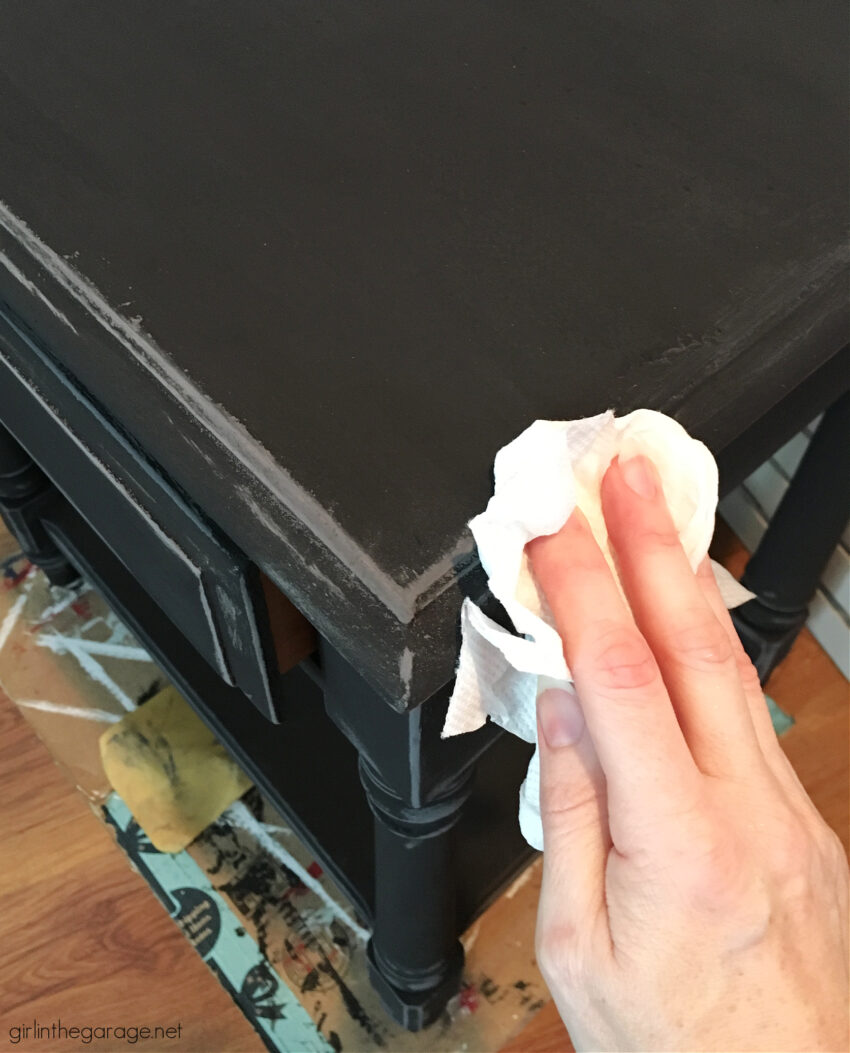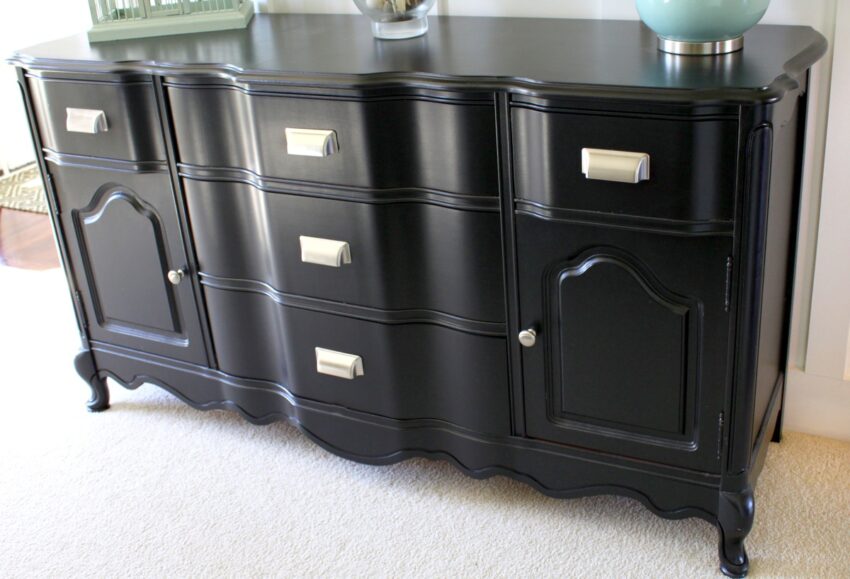
29 May How to Apply Black Paint for Wooden Furniture
Wooden furniture can be transformed with a simple change of color, and black paint is a timeless choice that adds sophistication and elegance to any space. Whether you want to refinish an old piece of furniture or give a new item a dramatic makeover, applying black paint can create a striking focal point in your interior design. In this article, we will guide you through the process of applying black paint to wooden furniture, ensuring a professional-looking finish that enhances the beauty and durability of your beloved pieces. This article is proudly presented by Thinkhousecreative.com.
When it comes to painting wooden furniture, the process requires careful preparation and the right techniques to achieve a flawless result. Black paint, in particular, requires attention to detail as any imperfections can be more noticeable. However, with the right guidance and a little patience, you can successfully transform your furniture into stunning pieces that exude style and sophistication.
Understanding the Benefits of Black Paint for Wooden Furniture

Image source: Google.com
Black paint offers several advantages when applied to wooden furniture. Firstly, it provides a timeless and versatile look that complements various interior styles, from classic to contemporary. Black furniture acts as a strong focal point and can anchor a room’s design, creating a bold and captivating atmosphere. Additionally, black paint can help conceal minor flaws or imperfections in the wood, making it a great choice for reviving older or worn-out furniture pieces.
As a bonus, if you’re looking for an Ikea suspension rail alternative to the typical installation method, such as using an Ikea suspension rail, black furniture can offer a striking alternative that adds character and style to your space. With its ability to effortlessly blend with different decor styles and its knack for disguising blemishes, black paint truly proves to be a versatile and transformative choice for wooden furniture.
Preparing the Wooden Surface
Before applying black paint, it’s crucial to prepare the wooden surface properly. This ensures better paint adhesion and a smoother finish. Follow these steps for surface preparation:
Cleaning the Surface
Start by cleaning the furniture surface to remove any dust, dirt, or grease. Use a mild soap solution and a soft cloth to wipe down the entire piece. Make sure to remove any existing wax, varnish, or paint residues, as they can interfere with the paint’s adhesion.
Sanding the Surface
Next, sand the wooden surface lightly to create a smooth and even texture. Use fine-grit sandpaper or a sanding block, and sand in the direction of the wood grain. Sanding helps remove any rough spots or imperfections, ensuring a clean canvas for the paint.
Applying a Primer
To enhance paint adhesion and prevent wood tannins from bleeding through, apply a primer to the surface. Choose a primer specifically designed for wooden surfaces and follow the manufacturer’s instructions. Priming helps create a stable base and promotes better coverage and durability of the black paint.
Choosing the Right Type of Black Paint
There are different types of black paint available, each with its own characteristics and application methods. Consider the following options when selecting the right black paint for your wooden furniture:
Oil-Based Paint
Oil-based paint offers excellent durability and a smooth, glossy finish. It is ideal for high-traffic furniture pieces that require extra protection. However, oil-based paints have a strong odor, longer drying times, and can be challenging to clean up.
Latex Paint
Latex or water-based paint is a popular choice for furniture painting due to its easy application, quick drying time, and minimal odor. It offers good durability and is available in various finishes, including matte, satin, and semi-gloss. Latex paint is also easier to clean up with soap and water.
Chalk Paint
Chalk paint has gained popularity in recent years for its unique matte finish and shabby-chic aesthetic. It adheres well to various surfaces, including wood, and requires minimal surface preparation. Chalk paint can be easily distressed to create a vintage or rustic look.
Applying Black Paint to Wooden Furniture
Now that you have prepared the wooden surface and chosen the right type of black paint, it’s time to apply the paint. Here are three common techniques for applying black paint to wooden furniture:
Brushing Technique
The brushing technique is the most common method of applying paint to wooden furniture. Use a high-quality paintbrush with synthetic bristles, designed for the type of paint you’re using. Start by applying thin and even coats, working in the direction of the wood grain. Allow each coat to dry completely before applying the next one.
Spraying Technique
Spraying black paint onto wooden furniture can provide a smooth and flawless finish. Use an HVLP (high volume, low-pressure) paint sprayer for the best results. Follow the manufacturer’s instructions for mixing the paint and adjust the sprayer settings accordingly. Apply several thin coats, allowing proper drying time between each coat.
Roll-on Technique
The roll-on technique is suitable for larger furniture pieces with flat surfaces, such as tabletops or dressers. Use a foam roller designed for smooth surfaces and apply thin coats of black paint. Roll in one direction to achieve a consistent finish. Again, allow each coat to dry before applying additional layers.
Tips for Achieving a Smooth and Even Finish
To ensure a professional-looking result when applying black paint to wooden furniture, consider the following tips:
Applying Thin Coats
It’s better to apply multiple thin coats of paint rather than one thick coat. Thin coats dry faster, adhere better, and minimize the risk of drips or brush marks. Building up the layers gradually helps achieve a smooth and even finish.
Sanding Between Coats
For the best results, lightly sand the surface between each coat of paint. Use fine-grit sandpaper or a sanding sponge to smooth out any imperfections, bubbles, or brush strokes. Sanding between coats creates a smooth surface for the next layer of paint to adhere to.
Using a Quality Brush or Roller
Invest in a high-quality paintbrush or foam roller to ensure a smooth application. Cheap brushes or rollers can shed bristles or leave texture on the surface. A good brush or roller helps distribute the paint evenly, reducing the need for touch-ups.
Adding Depth and Texture with Distressing Techniques
If you want to add character and charm to your black-painted furniture, consider using distressing techniques. These methods create a weathered or vintage appearance, enhancing the visual interest of the piece. Here are some popular distressing techniques:
Sanding for a Distressed Look
Gently sand the edges, corners, and raised areas of the furniture piece to expose the underlying wood or previous layers of paint. Sand strategically to mimic natural wear and tear or focus on areas that would naturally experience more use.
Using Crackle Medium
Crackle medium creates a crackled or aged effect on the painted surface. Apply a layer of crackle medium over the dried black paint, following the product instructions. Once the medium is dry, apply a contrasting color of paint. As the top layer dries, it cracks and reveals the black paint underneath.
Dry Brushing Technique
Dry brushing involves applying a small amount of paint to a dry brush and then lightly brushing it onto the furniture surface. This technique creates a textured and distressed look, as only a small amount of paint transfers onto the surface, leaving some areas exposed.
Protecting the Black Painted Surface
To ensure the longevity of your black-painted furniture, it’s essential to protect the painted surface from damage, wear, and tear. Consider the following options for protecting the finish:
Applying a Clear Protective Finish
To protect the black paint and enhance its durability, apply a clear protective finish over the painted surface. Choose a water-based polyurethane or varnish suitable for painted surfaces. Apply multiple thin coats, allowing each coat to dry completely.
Using Wax or Polyurethane
Another option for protecting black-painted furniture is to apply furniture wax or polyurethane. Wax provides a soft sheen and a smooth feel to the surface. Polyurethane offers a durable and protective finish. Follow the product instructions for proper application and drying times.
Maintenance and Care Tips
To keep your black-painted furniture looking its best, follow these maintenance and care tips:
Regular Dusting and Cleaning
Dust your black-painted furniture regularly with a soft cloth or a feather duster to prevent the buildup of dirt and debris. Avoid using abrasive cleaners or rough sponges, as they can damage the paint finish. For regular cleaning, use a mild soap solution and a damp cloth.
Avoiding Harsh Chemicals
When cleaning your black-painted furniture, avoid using harsh chemicals, ammonia-based cleaners, or solvents. These can strip away the protective finish or damage the paint. Stick to mild, non-abrasive cleaners specifically formulated for painted surfaces.
Touching Up Scratches and Chips
Over time, your black-painted furniture may develop small scratches or chips. To address these issues, use a small brush and touch-up paint that matches the original black color. Apply the paint carefully to the affected areas, feathering the edges to blend with the surrounding paint.
Enhancing the Aesthetics with Decorative Techniques
Once you’ve mastered the basics of applying black paint to wooden furniture, you can take your creativity further by incorporating decorative techniques. These techniques allow you to personalize your furniture and create unique statement pieces. Consider the following decorative options:
Stenciling
Stencil designs can add intricate patterns or motifs to your black-painted furniture. Choose stencils that complement your overall design aesthetic and use contrasting paint colors to create visual interest. Secure the stencil in place and use a stencil brush or sponge to apply the paint evenly.
Decoupage
Decoupage involves applying cut-out paper or fabric designs onto the furniture surface and sealing them with a protective finish. It offers endless possibilities for adding texture, patterns, or even vintage imagery to your black-painted furniture.
Gilding
Gilding is a technique that involves applying a thin layer of gold or metallic leaf to the furniture surface. This technique adds a touch of luxury and elegance to your black-painted furniture. Follow the product instructions for proper application and sealing.
Examples of Stunning Black Painted Furniture
To inspire your creativity, here are some examples of stunning black-painted furniture:
- Black-painted wooden dresser with distressed edges and antique brass hardware, adding a vintage touch to a modern bedroom.
- Black painted dining table with a matte finish, paired with white upholstered chairs, creating a chic and sophisticated dining area.
- Black painted bookshelf with stenciled geometric patterns, transforming a simple piece into a statement-making focal point in a living room.
Conclusion
Applying black paint to wooden furniture is a transformative process that allows you to breathe new life into your pieces. By following the proper preparation, painting, and finishing techniques outlined in this article, you can achieve a professional and visually stunning result. Remember to choose the right type of paint, apply thin coats, and protect the painted surface for long-lasting beauty. With a little creativity and attention to detail, your black-painted furniture will become a focal point in your home, showcasing your personal style and enhancing the overall ambiance.
You may like to read How to Install Spray Paint Bathroom Cabinets



Sorry, the comment form is closed at this time.